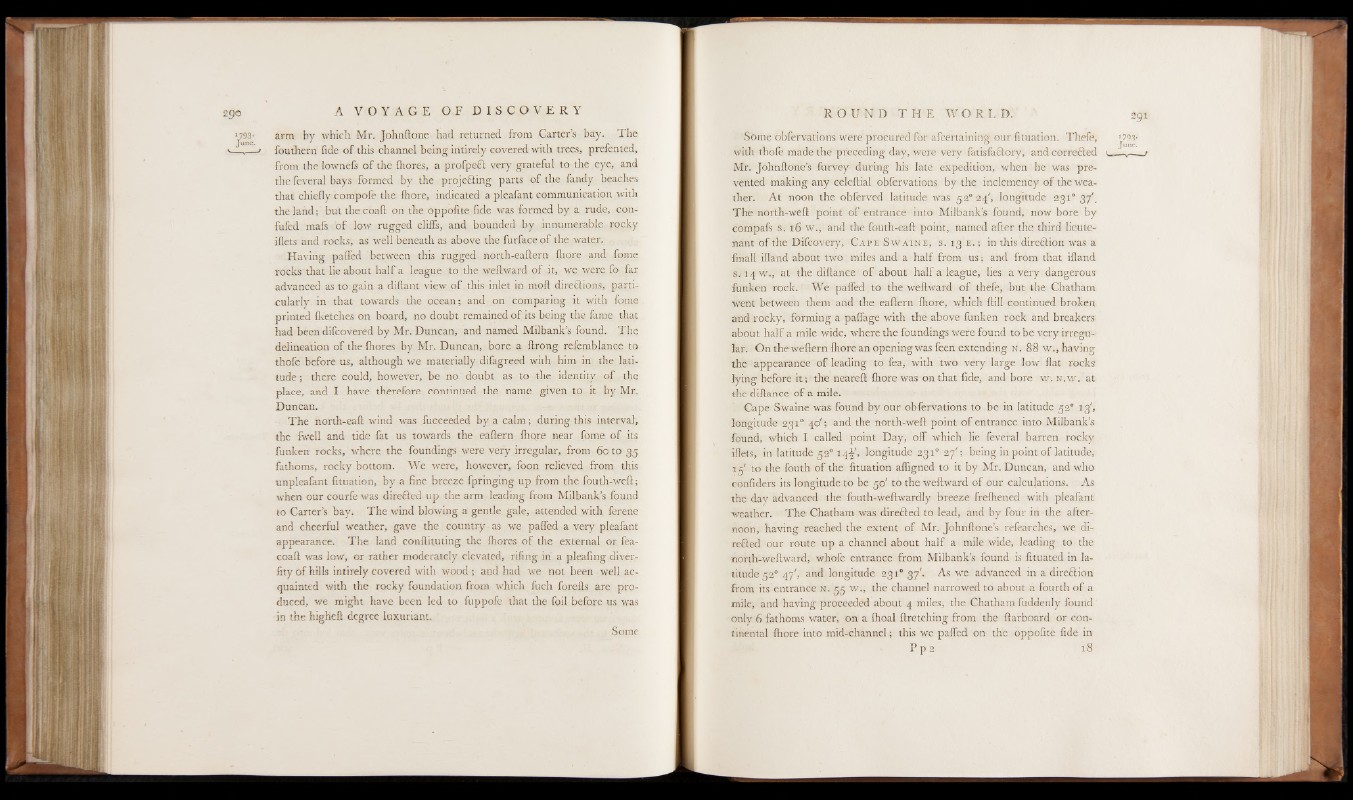
>793-
June.
arm by which Mr. Johnftone had returned from Carter’s bay. The
fouthern fide of this channel being intirely covered with trees, prefented,
from the lownels o f the Chores, a profpeft very grateful to the eye, and
the feveral bays formed by the projecting parts of the fandy beaches
that chiefly compofe the Ihore, indicated a pleafant communication with
the land; but the coaft on the oppofite fide was formed by a rude, con-
fufed mafs o f low rugged cliffs, and bounded by innumerable rocky
iflets and rocks, as well beneath as above the furface o f the water.
Having paffed between this rugged north-eaftern Ihore and fome
rocks that lie about half a league to the weftward of it, we were fo far
advanced as to gain a diftant view of. this inlet in moil directions, particularly
in that towards the ocean; and on comparing it with fome
printed {ketches on board, no doubt remained of its being the fame that
had been difeovered by Mr. Duncan, and named Milbank’s found. The
delineation of the Ihores by Mr. Duncan, bore a ftrong refemblance to
thofe before us, although we materially difagreed with him in the latitude;
there could, however, be no doubt as to the identity o f the
place, and I have therefore continued the name given to it by Mr.
Duncan.
The north-eaft wind was fucceeded by a calm; during this interval,
the fwell and tide fat us towards the eaftern Ihore near fome of its
funken' rocks, where the foundings were very irregular, from 60 to 35
fathoms, rocky bottom. We were, however, foon relieved from this
unpleafant fituation, by a fine breeze fpringing up from the fouth-weft;
when our courfe was directed up the arm leading from Milbank’s found
to Carter’s bay. The wind blowing a gentle gale, attended with ferehe
and cheerful weather, gave the. country as we paffed a very pleafant
appearance. The land conftituting the Ihores of the external or fea-
coaft was low, or rather moderately elevated, riling in a pleafing diver-
fity of hills intirely covered with wood ; and had we not been well acquainted
with the rocky foundation from which fuch foreffs are produced,
we might have been led to fuppofe that the foil before us was
in the higheft degree luxuriant.
Some
Some obfervations were procured for afeertaining our fituation. Thefe,
with thofe made the preceding day, were very fatisfaCtory, and corrected
Mr. Johnftone’s furvey during his late expedition, when he was prevented
making any celeftial obfervations by the inclemency of the weather.
A t noon the obferved latitude was 52° 24', longitude 231* 37'.
The north-weft point o f entrance into Milbank’s found, now bore by
compafs s. 16 w., and the fouth-eaft point, named after the third lieutenant
o f the Difcovery, C a p e S w a i n e , s . 13 e . ; in this direction was a
fmall ifland about two miles and a half from us; and from that ifland
s.i 14 w., at the diftanee o f about half a league, lies a very dangerous
funken rock. We paffed to the weftward o f thefe, but the Chatham
went between them and the eaftern fhore, which ftill Continued broken
and rocky, forming a paffage with the above funken rock and breakers
about half a mile wide, where the foundings were found to be very irregular.
On the weftern Ihore an opening was feen extending n . 88 w., having
the appearance of leading to fea, with two very large low flat rocks
lying before it; the neareft fhore was on that fide, and bore w . n .w . at
the diftanee of a mile.
Cape Swaine was found by our obfervations to be in latitude 52* 13',
longitude 231° 46'; and the north-weft point of entrance into Milbank’s
found, which I called point Day, off which lie feveral barren rocky
iflets, in latitude 52” 14^', longitude 231° 27'; being in point of latitude,
13' to the fouth of the fituation alfigned to it by Mr. Duncan, and who
confiders its longitude to be 50' to the weftward of our calculations. As
the day advanced the fouth-weftwardly breeze frelhened with pleafant
weather. The Chatham was direCted to lead, and by four in the afternoon,
having reached the extent of Mr. Johnftone’s refearches, we directed
our route up a channel about half a mile wide, leading to the
north-weftward, whofe entrance from Milbank’s found is fituated in latitude
520 47', and longitude 231' 37'. As we advanced in a direction
from its entrance N. 55 w., the channel narrowed to about a fourth of a
mile, and having proceeded about 4 miles, the Chatham fuddenly found
only 6 fathoms water, on a fhoal ftretching from the {larboard or continental
fhore into mid-channel; this we paffed on the oppofite fide in
P p 2 18